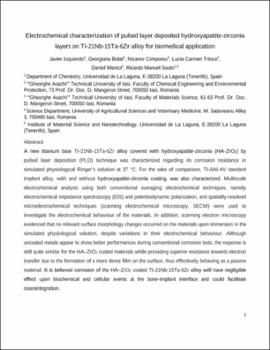Electrochemical characterization of pulsed layer deposited hydroxyapatite zirconia layers on Ti-21Nb-15Ta-6Zr alloy for biomedical application
Date
2016Abstract
A new titanium base Ti-21Nb-15Ta-6Zr alloy covered with hydroxyapatite-zirconia (HA-ZrO2) by pulsed laser deposition (PLD) technique was characterized regarding its corrosion resistance in simulated physiological Ringer’s solution at 37 °C. For the sake of comparison, Ti-6Al-4V standard implant alloy, with and without hydroxyapatite-zirconia coating, was also characterized. Multiscale electrochemical analysis using both conventional averaging electrochemical techniques, namely electrochemical impedance spectroscopy (EIS) and potentiodynamic polarization, and spatially-resolved microelectrochemical techniques (scanning electrochemical microscopy, SECM) were used to investigate the electrochemical behaviour of the materials. In addition, scanning electron microscopy evidenced that no relevant surface morphology changes occurred on the materials upon immersion in the simulated physiological solution, despite variations in their electrochemical behaviour. Although uncoated metals appear to show better performances during conventional corrosion tests, the response is still quite similar for the HA–ZrO2 coated materials while providing superior resistance towards electron transfer due to the formation of a more dense film on the surface, thus effectively behaving as a passive material. It is believed corrosion of the HA–ZrO2 coated Ti-21Nb-15Ta-6Zr alloy will have negligible effect upon biochemical and cellular events at the bone-implant interface and could facilitate osseointegration






